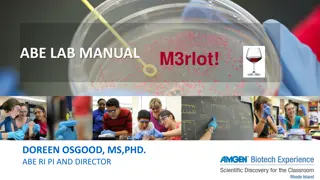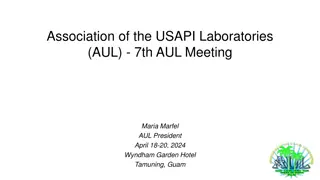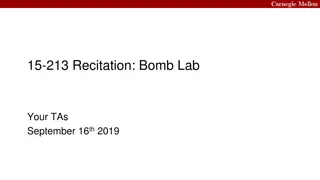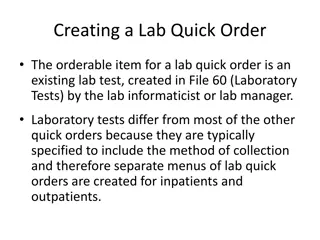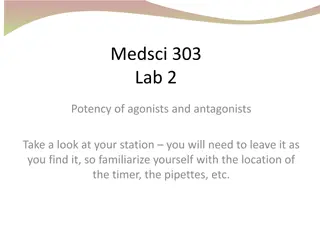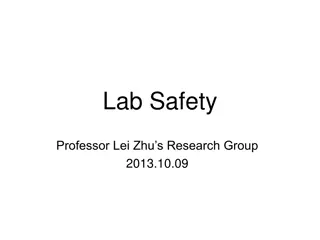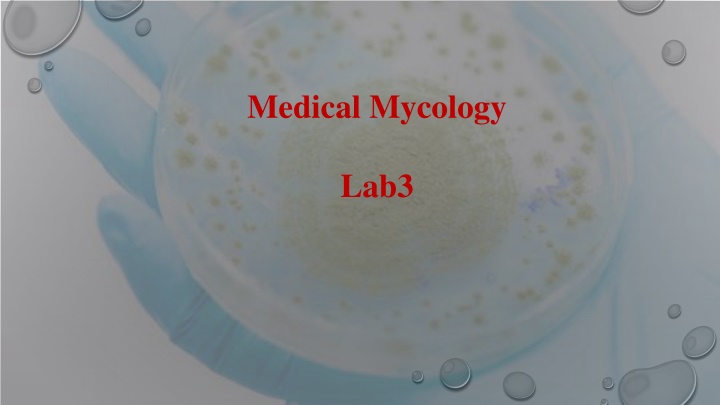
Mycosis: Types and Laboratory Diagnosis
Learn about mycosis, an infection caused by fungi, classified into superficial, subcutaneous, and systemic types. Explore the causes, symptoms, and laboratory diagnosis methods for effective treatment.
Download Presentation

Please find below an Image/Link to download the presentation.
The content on the website is provided AS IS for your information and personal use only. It may not be sold, licensed, or shared on other websites without obtaining consent from the author. If you encounter any issues during the download, it is possible that the publisher has removed the file from their server.
You are allowed to download the files provided on this website for personal or commercial use, subject to the condition that they are used lawfully. All files are the property of their respective owners.
The content on the website is provided AS IS for your information and personal use only. It may not be sold, licensed, or shared on other websites without obtaining consent from the author.
E N D
Presentation Transcript
Medical Mycology Lab3
What is mycosis? Mycosis, in humans and other animals, an infection caused by any fungus that invades the tissues. ClassificationBased on **The Site of infection 1)Superficial or Cutaneous mycoses 2)Subcutaneous mycoses 3)Systemic mycoses
1) Superficial or Cutaneous mycoses : Caused by fungi that affect the superficial layers of skin, hair, and nails Cutaneous mycoses are caused by Dermatophytes ( which is a group of filamentous fungi) Also can be caused by the Candida thatcannaturally present on the skin and mucous membranes. When the amount of Candida is low, it is harmless, but when it starts to overgrow, it can damage the skin and nearby tissues. *weak immune system is often the reason for Candida overgrowth.
2) Subcutaneous mycoses: Subcutaneous mycoses cause infections of the skin and underlying tissue The wounds/cuts in the skin allows fungi from the environment to enter the skin and gain access to deeper tissues. One of the major forms is Sporotrichosis also known as rose handler's disease, caused by Sporothrix schenckii Symptoms of this form include nodular lesions or bumps in the skin Naturally found in soil, and usually affects farmers , gardeners, and agricultural workers The infection is characterized by the formation of nodules and ulceration at the site of infection.
3) Systemic mycoses: affect internal organs (e.g., lungs, brain, gastrointestinal tract , blood) The fungi enter the body via the lungs, through the gut, or skin. The fungi can then spread via the bloodstream to multiple organs Often causing multiple organs to fail and eventually resulting in the death of the patient Example: Histoplasmosis is a fungal infection caused by the fungus (Histoplasma capsulatum) which grows in soil and material contaminated with bat and bird droppings
laboratory diagnosis of fungal infections Early and accurate diagnosis of fungal infection is critical for effective treatment. Common approaches for the laboratory diagnosis of fungal infections are: 1.Direct microscopic examination of clinical samples 2.Culture of the organism 3.histopathology 4.Serological tests 5.Molecular diagnostics (DNA probe tests)
Direct Microscopic Examination Direct microscopic examination of clinical specimens such as : skin scrapings, hair, and nails is a common method It provides a rapid and accurate diagnosis of some fungal infections.
Various dyes can be used to stain and examine fungal features (e.g. spores, hyphae etc) which helps in the identification. Potassium Hydroxide KOH (10-20%): A recommended method for the direct microscopic examination Lactophenol-cotton blue (LCB) : Lactophenol: preserves fungal structures and kills the fungus. Cotton blue: stains the fungal elements Calcofluor white: Fluorescent Stain- excellent to examine the morphology of pathogenic fungi Binds with cellulose and chitin contained in the cell walls of the fungi You will need fluorescence microscope which requires skills to work with It is expensive Giemsa Stain: It is a Nucleic acid stain. Methylene blue is the basic dye that is responsible for staining the acidic components of the cell, particularly the nucleus 5% Giemsa stain solution for 20 30 minutes
Potassium hydroxide preparation (KOH) KOH is a strong alkali. Method Potassium hydroxide preparation (KOH mount) Use Clearing of specimens to make fungi more visible (How?)*** Time Required 5 min; if clearing is not complete, an additional 5-10 min is necessary. Advantages Rapid detection of fungal elements Disadvantages Requires experience because background artifacts are often confusing; clearing of some specimens may require an extended time. *** When specimen such as skin, hair, nails or sputum is mixed with 10-20 % KOH, it softens, digests and clears the tissues (e.g., keratin present in skins) surrounding the fungi (leavingalkali-resistant fungi intact) so that the hyphae and spores can be seen under a microscope.
Preparation of the KOH mount Using a pipette/dropper, place a drop of KOH solution on a clean slide. Transfer small quantity of the specimen with the tip of a scalpel into the KOH drop. Put a clean cover slip over the drop gently so that no air bubble is trapped. Place the slide on hot plate for few minutes. Use 10X or 40X objectives to describe fungal isolate Results Negative (Normal) : The absence of the fungus in the sample Positive (abnormal): when some Fungus observed in the samples
(2) Laboratory investigation of superficial fungal infections YouTube Start at 1.28
2. Culture Fungi are frequently cultured on Sabouraud dextrose agar (SDA) which facilitates the appearance of the slow-growing fungi by inhibiting the growth of bacteria. **Inhibition of bacterial growth is due to the low pH of the medium and use of antibiotics. Fungi develop varying characteristics on different media, so it is important to describe the characteristics on a standard medium such as Sabouraud Dextrose Agar (SDA). Medically important fungi are normally described by their appearance on SDA, which is one reason this medium continues to be used as the primary isolation medium
Fungal colony is identified by rapidity of growth, color, and morphology Colony characteristics of the isolate, and the nature of the asexual spores, mycelium are sometimes sufficient to identify the common pathogens but identification of less common fungi requires further examination The inoculated media should be incubated at 25 37 C for (7 days -14 days and up to 4 weeks) Culture method is time-consuming in most cases
There are signs of fungal infection, however you got a negative culture result Why !!!! Inadequate specimen The presence of non-viable hyphae elements in the distal region of a nail An uneven colonization of a nail with the fungus Anti-fungal treatment used prior to collection of the specimen A delay in the specimen reaching the laboratory Incorrect laboratory procedures Slow growth of the organism


